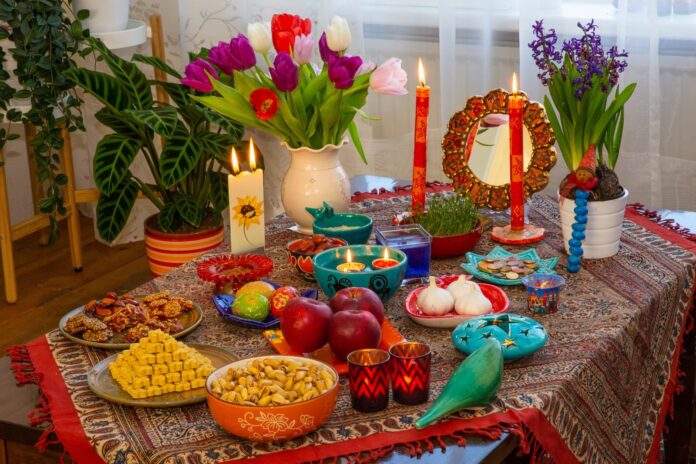By Jafar Ronas
Marking cultural events and festivals is common to nations worldwide. These celebrations and festivals not only symbolize different historical and cultural practices but also bring families and communities closer together, and introduce new generations to traditional customs and traditions.
Similarly, every year, as March arrives, a transformation takes place. The shift from winter to spring brings about a profound sense of renewal and revitalization, both in the natural world and within oneself. The air becomes fresher, the sun warmer and the mind clearer. Nowruz is an Iranian or Persian festival that has been celebrated for thousands of years. Nowruz begins at the exact moment of the Northern Hemisphere’s vernal equinox, typically between March 19 and 22, that heralds the arrival of spring and signifies hope and rejuvenation.
This Iranian event has become a global phenomenon, celebrated, and respected by people of different communities, and it became a popular celebration in communities that grew out of Persian-influenced cultural regions such as Iran, Pakistan, Iraq, Tajikistan, Uzbekistan, Azerbaijan, Turkey and Afghanistan. In recognition of the significance of this ancient rite, Nowruz was inscribed on UNESCO’s Representative List of the Intangible Cultural Heritage of Humanity in 2009. Moreover, in 2010, the United Nations General Assembly proclaimed the March 21 as International Nowruz Day.
In the Islamic Republic of Iran, Nowruz is a time for unity that emphasizes the importance of family and community, and of the resilience and hope that lies at the heart of the human spirit. Families and friends gather and celebrate the end of one year and the beginning of the next.
In Iran, Nowruz is followed by four days of public holidays, and schools and universities close for two weeks. Throughout the holiday period friends and family gather at each other’s houses for meals, spend time together and exchange traditional gifts. Although the traditions and customs that accompany the celebration of Nowruz vary from province to province, there are common traditional traits.
Nowruz is consisted of traditional cultural activities, combining common practices with local customs. Iranians start their preparation for the festivities weeks beforehand. They thoroughly wipe and polish their homes, repair or replace any broken thing, decor homes with flowers. The essence of this tradition encourages cleaning bad luck and misfortune out of your home and prepare for better things to come in the new year.
One widespread tradition is the preparation of a Nowruz table or “Sofreh-ye Haft Sin”, that displays seven symbolic objects: Seeb (apple), Sikeh (coin), Sirkeh (vinegar), Seer (garlic), Sonbol (hyacinth flower), Samanu (wheat sprout pudding), Sabzeh (sprouted wheat grass), Senjed (oleaster fruit) each symbolizes purity, brightness, abundance, happiness and fertility for the new year. Some families even add a little more flair by including Sumac, Aineh (mirror), the Holy Quran, Divan e Hafez, Sha’m(candle), Tokhm e Morgh (egg) and all kinds of sweets and fruits.
Holy Quran is the first object Iranians place on the table while preparing the Haft Sin table. They place Quran on their Haft-seen table to begin the New Year with faith in and an appeal to the Almighty after the advent of Islam in Iran and Persians converted to Islam. Likewise, the non-Muslim Iranians, according to their religions, keep their holy books on the Haft-Seen table, as for Christians, reciting the Bible is one of the mainstays of Nowruz, and so do Zoroastrians recite the Avesta and Jews have Torah on their table.
The excitement leading up to Nowruz is palpable. As Nowruz approaches, streets in Iran come alive with the vibrant presence of Haji Firoz and Amoo Nowruz. Haji Firoz and Amoo Nowruz are two traditional characters in Iranian culture who are associated with the celebration of Nowruz and appear annually at the beginning of the spring. Haji Firoz, in his striking red attire and distinctive charcoal-painted face, adds a touch of exuberance to the pre-Nowruz atmosphere and Amoo Norouz, the elderly guardian of the New Year, symbolizes renewal and hope.
Nowruz is preceded by Chahar Shanbe Suri, that is celebrated on the eve of the last Wednesday of the Persian Year. Chahar Shanbe Suri is the eve marking special customs and rituals, most notably jumping over fire.
The Nowruz festivities end on the thirteenth day after Nowruz with observance Sizdeh Bedar-Iran’s Nature Day Celebration, a custom that involves picnicking outside to ward off bad luck. The families go on picnics and take with them the Sabzeh from their haft-sin table and people discard it back to nature. The countryside is full of families enjoying the last day of the holidays.
Pakistan and Iran enjoy common cultural, linguistic, religious and traditional roots and the proportion of commonality from a cultural point of view is quite high. Khana Farhang Iran-Lahore since 1956, has been playing a significant role in establishing long lasting and deep relations between the two brotherly nations and serving purpose of promoting domestic culture and facilitating bilateral cultural exchanges.
Every year, as the cultural representative of the Islamic Republic of Iran in Lahore, Khana Farhang Iran-Lahore celebrates Nowruz festivity, to bring the historical and cultural heritage of Iran to Zinda Dalan e Lahore.
The author is Cultural Attaché, Khana-e-Farhang Islamic Republic of Iran, Lahore.























